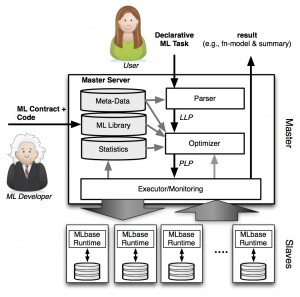Machine learning (ML) and statistical techniques are key to transforming big data into actionable knowledge. In spite of the modern primacy of data, the complexity of existing ML algorithms is often overwhelming—many users do not understand the trade-offs and challenges of parameterizing and choosing between different learning techniques. Furthermore, existing scalable systems that support machine learning are typically not accessible to ML researchers without a strong background in distributed systems and low-level primitives.
To address these issues we are building MLbase, a novel system harnessing the power of machine learning for both end-users and ML researchers. MLbase provides (1) a simple declarative way to specify ML tasks, (2) a novel optimizer to select and dynamically adapt the choice of learning algorithm, (3) a set of high-level operators to enable ML researchers to scalably implement a wide range of ML methods without deep systems knowledge, and (4) a new run-time optimized for the data-access patterns of these high-level operators.
MLbase will ultimately provide functionality to end users for a wide variety of common machine learning tasks: classification, regression, collaborative filtering, and more general exploratory data analysis techniques such as dimensionality reduction, feature selection and data visualization. Moreover, MLbase provides a natural platform for ML researchers to develop novel methods for these tasks. Our vision paper describing MLbase has been accepted to the Conference on Innovative Data Systems Research (CIDR), and we will present MLbase at the NIPS workshop on Big Learning in December and at CIDR in January. We also have several demos planned in the upcoming months. Please visit our project website for more details and/or to contact us.

